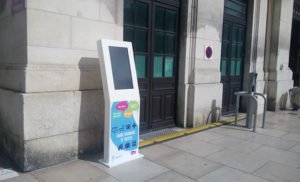The issue of digital access for homeless people has given rise to a whole series of initiatives in recent years: a "digital safe" that allows homeless people to keep their identity papers, an online census of useful addresses and services such as day care centers, food distribution in the vicinity or shower baths, and the provision of cell phones...
In 2012, INSEE estimated that there were 143,000 homeless people (i.e., people who had used an accommodation service or slept in a place not intended for habitation the previous night): their number had increased by 50% between the two INSEE studies of 2001 and 2012. The majority of homeless people are men, but the proportion of women and children is increasing and represents a little more than a third of the homeless (37%). The average age in 2012 was 39, but they were increasingly over 60 (10% of the homeless in 2012). 62% of the homeless lived alone, 17% in couples with one or more children, 12% alone with one or more children, and 9% in couples without children.
There is a widely held stereotype that people on the street do not have access to digital technologies or the skills to take advantage of them when they do. This is far from the case.
Social Good Week 2018 had, moreover, devoted a round table to the digital practices of homeless people around the question " ". The participants had observed, on this occasion, that the homeless people " by their practices and by their needs, move from within the associations in their digital transformation ".Can digital technology get people off the streets?
Référence :
The cell phone, a daily survival management tool
As part of her thesis, devoted to the Ethnography of digital practices of street people, Marianne Trainoir spent about a year immersed in four day care centers. She conducted biographical interviews with forty-five people who know or have known the street. Her aim is to understand how digital practices contribute to the daily struggle of homeless people "to maintain themselves".
The digital sociabilities observed by Marianne Trainoir concern first and foremost the friendly relations of the street. " Beyond interpersonal dialogues (written and oral), digital correspondences take the form of statuses and comments that become public or semi-public correspondences. Through these more or less directly addressed messages, the respondents share their tastes, their moods, their joys, their angers, their hobbies and their concerns (...) Social networks are, for some, a new space in which to relay struggles that are sometimes little invested in daily life. The people who have the most active digital sociability are those who are very involved in street culture.
Digital tools also help maintain family ties. It is, in fact, "the deficiencies in family sociability that create the most painful feeling of solitude. If telephone relationships are often conflictual, social networks allow to reintroduce distance, especially thanks to the absence of voice and the possibility of asynchronous exchanges. For the youngest, the accounts on the social networks constitute a space "conceded" to the family, in particular to the mother, to allow her to play her role.
Digital practices also aim at affiliation to a common social world. The stakes are "to be up to date" and "to be aware". Some of the practices observed are therefore justified by the fear of appearing marginal (...) Not finding a use for a socially valued technology, which we know many people use on a daily basis, provokes a real feeling of relegation, especially among the youngest, who have internalized the idea that it should be a "natural" part of their daily lives. They then experience a feeling of guilt and radical dissimilarity.
Moreover, "although this does not seem to be due to technical problems, mediated administrative procedures often put people on the street in a difficult situation. They willingly use the equipment (connected computer, telephone) of the reception structures in order to carry out their procedures while ensuring the presence of a trusted third party and the benefit of a secure environment. Interactions with social assistance, which are fundamentally unequal and often marked by misunderstanding, are always experienced as stigmatizing. They contribute to a form of reduction of the person to his or her deficiencies and impediments. They feed a fatigue, physically and morally felt, which is thus fought by concentrating on other things, notably entertainment and social practices.
Référence :
Great diversity of digital uses among the homeless public
The association Solinum, at the origin of digital projects in the field of social action, has just published a study, "Connected precariousness", carried out among 300 people in 16 French cities.
According to this study, "the majority of homeless people are equipped with cell phones, a tool that has become indispensable in their daily lives. In fact, 91% of those surveyed own a cell phone and 71% have a smartphone.
The study points out a certain heterogeneity in terms of access and use of digital tools: "a very wide range of use and understanding of digital among the homeless public".
- "Homeless people face various issues that make it more difficult for them to access digital technology, including limited internet access, recharging difficulties, and device theft.
- "The lack of resources and the absence of a place to live do not always allow them to benefit from a mobile subscription. Thus, most of them opt for a prepaid phone card (66%) rather than a mobile subscription (29%), although the prepaid card does not always allow access to the Internet.
- "People in migration are more likely to own a cell phone. 78% of respondents who are undocumented, asylum seekers, or have a residence permit own a smartphone, compared to 62% of French nationals. Asylum seekers are also the most frequent users of the Internet and the most frequent users of social networks.
- "In terms of digital skills, we also see a wide disparity across different socio-demographic characteristics. People between the ages of 18 and 40 perceive themselves to be most comfortable with digital. People with higher education are also more comfortable with digital. Finally, respondents who have been in a precarious situation for 1 to 5 years feel more comfortable than people who have been on the street for longer.
- "Regarding the frequency of internet use, the majority of respondents use the internet regularly. More than half of the respondents (55%) go online every day. However, 17% say they never use it, mainly because they lack skills (60%)."
- "62% of respondents never do their paperwork online. Most of our respondents use the Internet every day or almost every day, mainly for entertainment: watching movies or listening to music (40%), going on social networks (37%), or getting information on current events (24%).
Précarité Connectée: 6 recommendations for the digital inclusion of the homeless
Solinum concludes with a series of recommendations to improve the living conditions of homeless people.
- Offer adapted digital support and free training.
- Provide public digital equipment adapted to the practices and needs of homeless people.
- Deploy battery recharging points accessible to all.
- Improve Internet access in social structures (installation of wifi in accommodation centers, installation of self-service computers, etc.).
- To propose mobile offers and equipment at solidarity rates.
- Facilitate online procedures by making them more ergonomic and accessible to all, regardless of their digital skills or level of education.
Référence :
Soliguide brings together essential information for homeless people

In order to give back autonomy to homeless people and refugees, Soliguide maps on its website all the places that are essential to the daily life of a homeless person: where to put one's luggage, where to eat, where to wash, where to get medical care, where to find Internet access, etc. Soliguide centralizes several thousand places and services in Paris, Nantes and Bordeaux, in the departments of Hauts-de-Seine and Seine-Saint-Denis have been mapped by the association.
Two Soliguide interactive terminals, installed last June, help you find your way around Bordeaux.
Référence :
Entourage: a social network for solidarity and connecting homeless people with local residents

On the street, it is isolation that dehumanizes. The Entourage association has developed a mobile application that helps homeless people connect with neighbors in their neighborhood. The association reports 60,000 active participants on the application: associations, residents concerned about acting at their level against the loneliness of homeless people and homeless people.
Alain Mercuel, a psychiatrist and head of the Mental Health and Social Exclusion Mobile Team (SMES) at the Sainte-Anne Hospital in Paris, was involved in the development of the platform's content and believes that the work of residents can complement that of health care providers for homeless people suffering from mental health problems. "The important thing is to create a lasting bond. It is the repetition of encounters that will encourage the person to, one day, ask for help, and it is this humanity, this bonding, that a local resident brings compared to other actors, whether they are professionals or volunteers".
Entourage entered into a partnership with the Randstad Institute in April 2019 to set up a digital platform to help homeless people reintegrate into the workforce: Entourage Job.
Références :
A digital safe for people in precarious situations
The digital safe is a secure online service that allows people to keep their administrative and/or personal documents (ID card, driver's license, contracts, bills, statements, photos, etc.) and to access them via the Internet. The user chooses the nature of the documents he or she wishes to keep in this personal space.
The General Directorate for Social Cohesion (DGCS) and the National Union of Communal and Intercommunal Social Action Centers (UNCCAS) launched an experiment in July 2016 to evaluate the use and usefulness of the digital safe, both with the people supported but also with CCAS agents in the context of their missions.
This experiment was implemented in 16 social aid centers: it aimed to understand under what conditions the digital safe could facilitate access to rights and social support for the people concerned by fighting against the loss of their documents, and to what extent it could also be an effective tool for fighting against the digital divide.
- Five digital safe solution providers volunteered to participate in this experiment.
- More than 200 agents concerned had been trained and made aware of the digital safe
- In one year, nearly 3,000 people were offered a digital safe (of which 1,000 were actually opened).
On the occasion of the national "Social Cohesion and Digital" day, the DGCS and UNCASS presented the results of this experiment.





